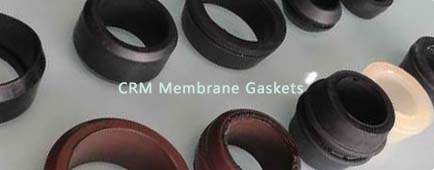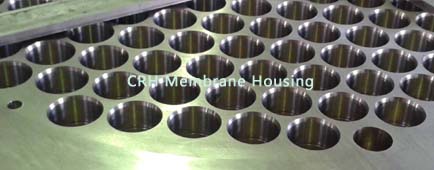General Properties of Elastomers and Plastics
EPDM (Ethylene Propylene Diene) exhibits strong resistance to ozone, certain hydraulic fluids, brake fluids, steam, and water over a wide temperature range of –50 to 250 degrees F. EPDM has gained increased use in the municipal water industry because of its resistance to water disinfected with chloramines. It has poor resistance to petroleum-based fluids, mineral oils, and solvents.
Viton (Fluorocarbon,
FKM) possesses a strong resistance to chemicals and air at high temperature applications to 400 degrees F. Viton is high in cost and is used in aircraft, automotive applications where resistance to petroleum oils, silicone fluids, and acids is needed. Viton also has superior chloramine resistance for drinking water applications.
Teflon (
PTFE), or Polytetrafluoroethylene, has outstanding resistance to chemical attack by most chemicals and solvents. PTFE has a temperature rating of -20 to 400 degrees F in valve applications. PTFE, a self lubricating compound, is used as a common seat and packing material in ball valves.
Buna-N (Nitrile, NBR), or copolymer of butadiene and acrylonitrile has excellent resistance to petroleum products, lubricants, and water over a wide temperature range of –50 to 200 degrees F. Nitrile is a widely used elastomer for hydraulic system o-rings. Buna-N does not have good resistance to outdoor exposure to ozone, sunlight, or weather.
Neoprene (Chloroprene, CR) is one of the first commercially available elastomers and is low in cost. Neoprene is unique with its moderate resistance to both petroleum products and oxygen over a wide temperature range of –50 to 200 degrees F. Neoprene is a widely used elastomer for seals with exposure to refrigerants, petroleum oils, and mild acids. Neoprene does not have good resistance to solvents such as MEK and acetone.
Hypalon (Chlorosulfonated Polyethylene, CSM) is similar to neoprene in chemical resistance and useful in the range of –50 to 200 degrees F for acid and ozone resistance.
Natural Rubber (Natural Polyisoprene, NR) is produced from various plants with excellent wear properties and resistance to brake fluid, water, sewage, but not petroleum products. Natural rubber is economical and commonly used for lining trucks, railroad cars, and valves for abrasion resistance. Natural rubber has been mostly replaced by synthetic elastomers for industrial seals.
Nylon (Polyamide) is one of the first thermoplastics used as rubber cords, belts, sports apparel, and structural parts such as valve bearings. Nylon has excellent resistance to oils and solvents, but limited resistance to alkalis and Acids. Its application is limited to a maximum temperature of 210 degrees F.
General Properties of Metals
Carbon Steel has very good mechanical properties, good resistance to stress corrosion and sulfides. Carbon steel has high and low temperature strength, is very tough, and has excellent fatigue strength. Steel can be easily cast or welded in making ANSI Pressure-Temperature rated valve bodies or structural parts for applications up to 850 degrees F.
304 SS is basic 18% chromium, 8% nickel austenitic stainless steel commonly used for valve trim. Its .08 max carbon content reduces intergranular corrosion usually associated with carbide precipitation that can occur during welding. It offers excellent resistance to a wide range of corrosives and atmospheric exposures.
316 SS is chemically similar to 304 SS except with the addition of molybdenum providing better corrosion and pitting resistance and higher strength at elevated temperatures. It is non-magnetic with greater ductility than 400SS. 316SS has excellent corrosion resistance in a wide range of environments, is not susceptible to stress corrosion cracking, and is not affected by heat treatment. Most common uses in valves are stem, body and ball materials.


